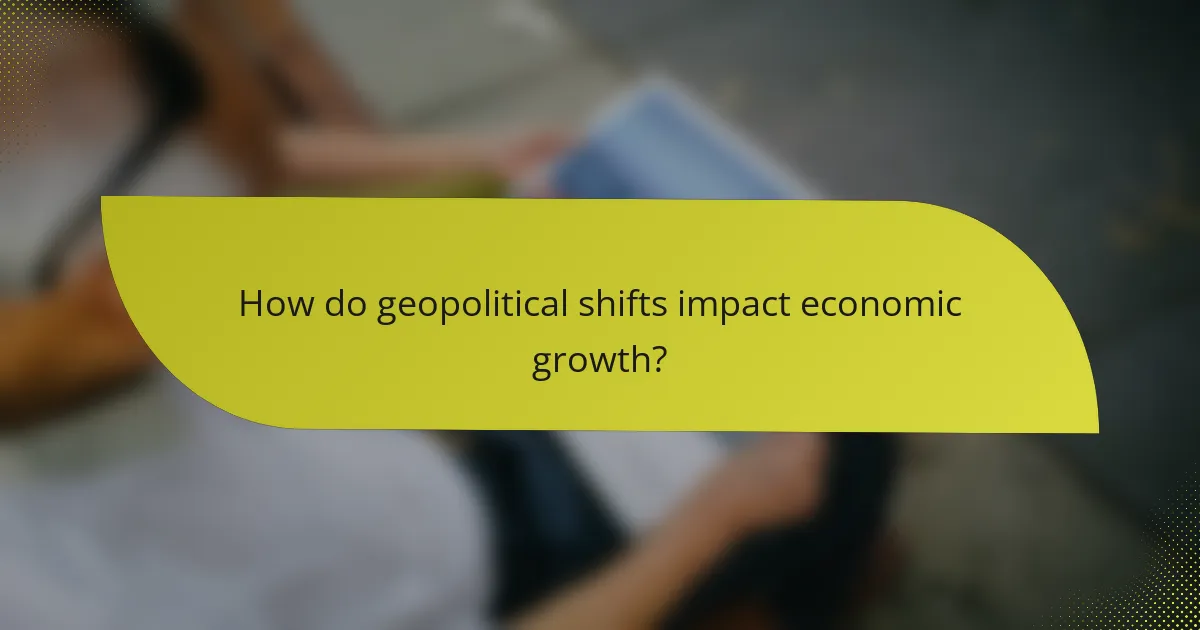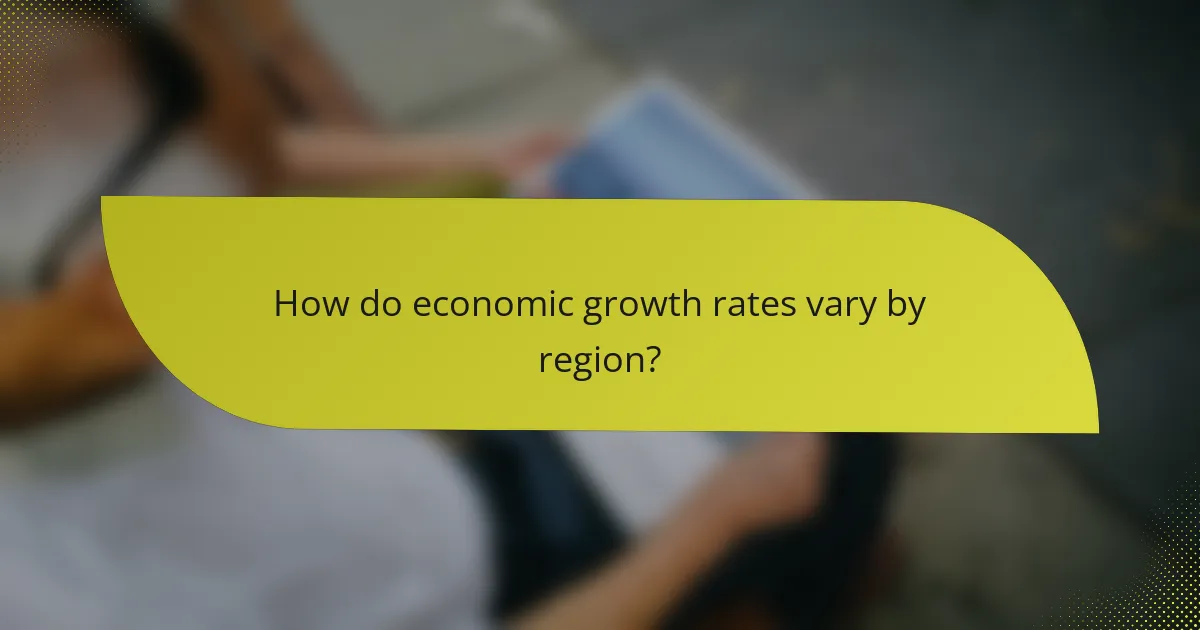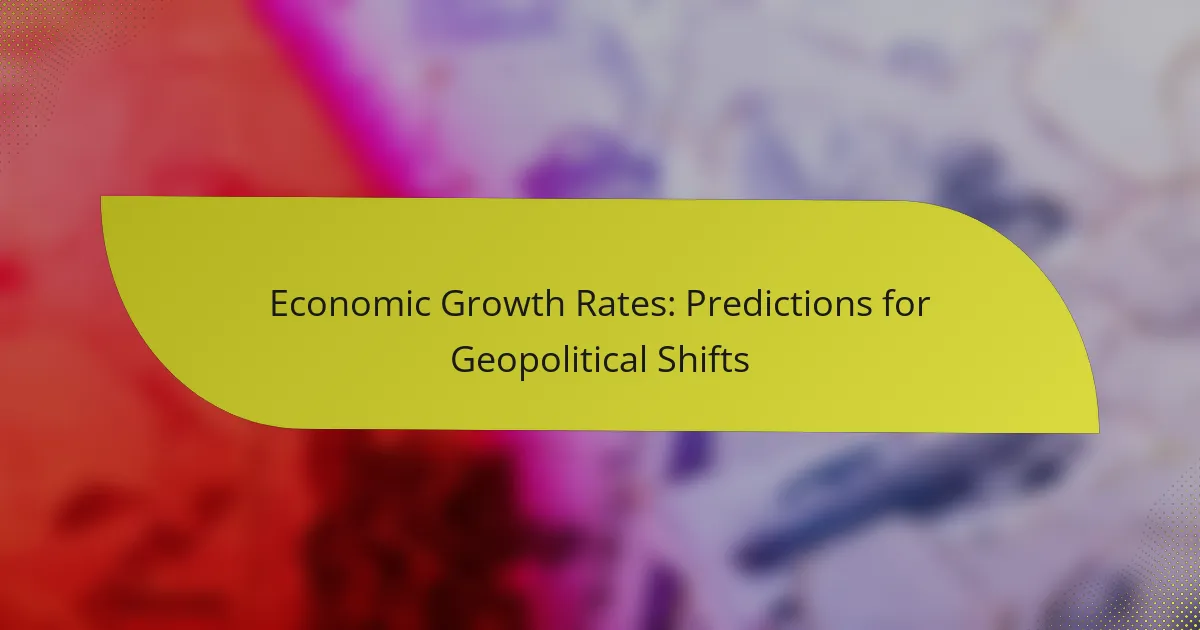As we look ahead, predictions for economic growth rates reveal a landscape shaped by geopolitical tensions, inflation, and recovery from recent global disruptions. These factors are expected to create a varied growth trajectory among major economies, with some poised for strong rebounds while others may experience stagnation. Geopolitical shifts will further impact trade dynamics and investment flows, influencing overall economic performance in the coming years.

What are the predicted economic growth rates for major economies?
Predictions for economic growth rates vary significantly among major economies, influenced by factors such as geopolitical tensions, inflation, and recovery from recent global disruptions. Analysts expect growth rates to fluctuate, with some economies rebounding strongly while others may face stagnation or slower growth.
United States growth forecast
The United States is projected to experience moderate growth in the coming years, with estimates generally ranging from 2% to 3% annually. Factors such as consumer spending, labor market conditions, and interest rates will play crucial roles in shaping this forecast.
Investors should monitor Federal Reserve policies and inflation trends, as these can significantly impact economic performance. A strong job market and increased business investments could push growth towards the higher end of the forecast range.
China growth forecast
China’s economic growth is expected to slow down compared to previous decades, with forecasts suggesting rates between 4% and 6%. This slowdown is attributed to structural changes in the economy, including a shift from manufacturing to services and increased regulatory scrutiny.
Key indicators to watch include domestic consumption trends and international trade relations, particularly with the United States. Continued investment in technology and infrastructure may help sustain growth within this range.
European Union growth forecast
The European Union is anticipated to see growth rates between 1% and 2% as it navigates challenges such as energy prices and geopolitical tensions. Economic recovery varies by member state, with some countries rebounding faster than others.
Monitoring the European Central Bank’s monetary policy and fiscal measures will be essential for understanding the overall economic landscape. Countries that adapt quickly to energy transitions may outperform their peers.
India growth forecast
India is projected to maintain robust growth, with estimates around 6% to 8% annually. This growth is driven by a young population, increasing urbanization, and government initiatives aimed at boosting infrastructure and manufacturing.
Investors should consider the impact of global economic conditions and domestic reforms on this growth trajectory. Continued focus on digitalization and sustainability could further enhance India’s economic prospects.
Brazil growth forecast
Brazil’s economic growth is expected to be modest, with forecasts ranging from 2% to 4%. Political stability and commodity prices will significantly influence this outlook, as Brazil is a major exporter of agricultural and mineral products.
Monitoring local economic policies and global demand for commodities will be crucial for understanding Brazil’s growth potential. Structural reforms aimed at improving business conditions could help push growth towards the higher end of the forecast range.

How do geopolitical shifts impact economic growth?
Geopolitical shifts significantly influence economic growth by altering trade dynamics, investment flows, and resource distribution. Changes in political relationships can lead to new trade agreements or tariffs, which directly affect market access and economic performance.
Trade agreements influence
Trade agreements play a crucial role in shaping economic growth by determining the terms of trade between countries. Favorable agreements can enhance market access, reduce tariffs, and stimulate exports, leading to increased economic activity. For instance, the North American Free Trade Agreement (NAFTA) boosted trade between the U.S., Canada, and Mexico, illustrating how such agreements can drive growth.
Conversely, geopolitical tensions can lead to trade barriers, negatively impacting economies. Countries facing sanctions or trade restrictions may experience slower growth due to limited access to markets and resources.
Political stability effects
Political stability is essential for fostering a conducive environment for economic growth. Stable governments tend to attract foreign investment, as investors seek predictable and secure markets. For example, countries with consistent governance often see higher levels of foreign direct investment, which can lead to job creation and infrastructure development.
On the other hand, political instability can deter investment and disrupt economic activities. Regions experiencing conflict or uncertainty may see capital flight and reduced consumer confidence, hindering growth prospects.
Resource allocation changes
Geopolitical shifts can lead to changes in how resources are allocated, impacting economic growth. For instance, a country that gains control over valuable resources may experience a boost in its economic output. The discovery of oil reserves in a politically stable region can attract investment and spur growth.
However, shifts in resource allocation can also create challenges. Nations that lose access to critical resources may face economic decline, necessitating adjustments in their growth strategies. Understanding these dynamics is crucial for policymakers aiming to navigate the complexities of global economics.

What are the key factors driving economic growth in 2024?
In 2024, economic growth will be primarily driven by technological advancements, labor market trends, and investment in infrastructure. These factors collectively influence productivity, employment rates, and overall economic stability.
Technological advancements
Technological advancements are crucial for boosting productivity and efficiency across various sectors. Innovations in artificial intelligence, automation, and data analytics are expected to enhance operational capabilities, leading to increased output and reduced costs.
Businesses that adopt new technologies can gain a competitive edge, particularly in industries like manufacturing and services. For example, companies utilizing AI for supply chain management may see significant improvements in inventory turnover and customer satisfaction.
Labor market trends
Labor market trends in 2024 will reflect shifts in workforce demands and skills. As automation rises, there will be a growing need for skilled workers who can operate and maintain advanced technologies. This shift may lead to wage increases in tech-related fields while potentially displacing lower-skilled jobs.
Employers should focus on upskilling their workforce to adapt to these changes. Investing in training programs can help bridge the skills gap and ensure that employees remain competitive in the evolving job market.
Investment in infrastructure
Investment in infrastructure is essential for supporting economic growth by improving transportation, utilities, and communication networks. Governments and private sectors are expected to allocate significant funds towards infrastructure projects, which can create jobs and stimulate local economies.
For instance, upgrading public transit systems can reduce congestion and enhance productivity, while investments in renewable energy infrastructure can lead to sustainable growth. Stakeholders should prioritize projects that offer long-term benefits and align with environmental goals.

How do economic growth rates vary by region?
Economic growth rates differ significantly across regions due to various factors such as resource availability, political stability, and technological advancement. Understanding these variations can help businesses and investors make informed decisions based on regional economic conditions.
Growth in North America
North America, particularly the United States and Canada, has experienced steady economic growth driven by innovation and consumer spending. The U.S. economy often grows at rates between 2% to 3% annually, while Canada typically sees slightly lower growth, around 1.5% to 2.5%.
Key sectors contributing to this growth include technology, finance, and healthcare. Businesses should consider the impact of trade agreements and regulatory changes, such as tariffs, which can affect market dynamics.
Growth in Asia-Pacific
The Asia-Pacific region is marked by diverse growth rates, with countries like China and India leading the way. China’s growth has slowed to around 5% to 6% recently, while India often sees growth rates exceeding 6% due to its young population and expanding middle class.
Investors should focus on emerging markets within this region, as they present significant opportunities. However, geopolitical tensions and regulatory environments can pose risks that need careful assessment.
Growth in Europe
Europe’s economic growth rates are generally lower, averaging around 1% to 2% across the Eurozone. Variability exists, with countries like Germany and France showing more resilience compared to southern European nations, which may struggle with higher unemployment and debt levels.
Businesses operating in Europe must navigate complex regulations and varying tax structures. Understanding the European Union’s policies can provide insights into potential growth areas and challenges in different member states.

What are the implications of economic growth for global markets?
Economic growth significantly influences global markets by affecting demand, investment, and trade dynamics. As economies expand, they can lead to increased consumer spending, higher commodity prices, and shifts in currency values, all of which impact international trade and investment strategies.
Impact on commodity prices
Economic growth typically drives up demand for commodities, leading to higher prices. For instance, robust growth in emerging markets often results in increased consumption of energy and raw materials, which can push prices higher. Investors should monitor growth indicators, as a surge in GDP can signal rising commodity costs.
Additionally, geopolitical factors can exacerbate these trends. For example, tensions in oil-producing regions can lead to price spikes, particularly if demand is already elevated due to strong economic performance elsewhere. Keeping an eye on both local and global growth trends is essential for predicting commodity price movements.
Effects on currency exchange rates
Economic growth can strengthen a country’s currency as higher growth rates attract foreign investment. Investors often seek to capitalize on stronger economic performance, leading to increased demand for that currency. For example, if the U.S. economy shows strong growth, the USD may appreciate against other currencies.
However, this relationship can be influenced by interest rates and inflation. If growth leads to higher inflation without corresponding interest rate hikes, the currency may weaken. Understanding the interplay between growth, inflation, and monetary policy is crucial for anticipating currency fluctuations.
Influence on investment flows
Strong economic growth tends to attract foreign direct investment (FDI) as companies seek to capitalize on expanding markets. Nations with robust growth prospects often see increased capital inflows, which can further stimulate their economies. For instance, countries in Southeast Asia have attracted significant FDI due to their rapid economic expansion.
Conversely, economic instability or slow growth can deter investment. Investors typically favor stable environments with growth potential, so monitoring economic indicators is vital for making informed investment decisions. Countries that can maintain steady growth are likely to see sustained investment interest.
